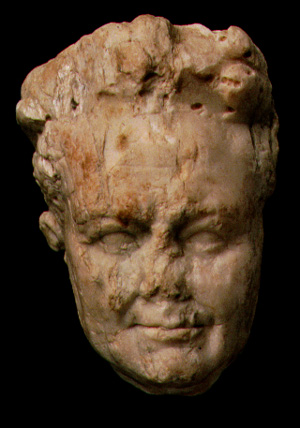

12. Head in Relief of Vespasian Wearing the Corona Civica (KM 2430)
 inv.
no. 2430
inv.
no. 2430Purchased by F. W. Kelsey in February 1901, from a "dealer at School" (probably the American School of Classical Studies)
max. h. 0.21 m; max. w. 0.17 m; max. d. 0.10 m
Pentelic marble
Broken at the back. Right side of face weathered more than left. Nose and lower half of right ear broken away; left ear missing; eyebrows chipped. Frontal portion of wreath heavily damaged. Random scratching, chipping, and weathered veining over whole surface. Traces of red pozzolana mortar on back of block and on parts of face. Portions of oak leaves preserved on either side of head.
Vespasian appears as an idealized aging man with furrowed cheeks, sagging flesh, and crow's feet at the corners of his eyes. His lips curve into a slight smile, and his eyes gaze upward, creating an expression of remote benevolence. He wears his hair in tightly curled snail-shell locks, each dotted with a drill hole. Single drill holes also mark the perimeters of the ragged-edged oak leaves of his corona civica. Although the face is plastically modeled, the workmanship on the whole, while expert, is not refined.
The pattern of weathering on the block suggests that the left side of the head was protected from the elements against the relief ground while the right was exposed. Vespasian's head would thus have turned in three-quarter view, gazing toward the observer's right. Koeppel (1984) estimated the height of the whole figure of Vespasian to have been 1.30-1.35 m. A. E. Haeckl (1977) first identified the portrait as that of Vespasian and proposed that the head was part of a Domitianic historical relief possibly belonging to "a dynastic monument such as the Temple of the Gens Flavia on the Quirinal." Koeppel (1980) pursued this line of inquiry and associated the portrait with other Pentelic marble fragments purchased by F. W. Kelsey in Rome in 1900-1901 and by P. Hartwig in 1901, all of which he assigned to the Flavian complex on the Quirinal.
Bibliography
Haeckl (1977)
16-17, cat. 4; Koeppel (1980) 15, 17-18; 21, cat. 4; 24, fig. 4; Koeppel
(1984) 14; 59-61, cat. 27, figs. 40-42.
Catalogue entry by Elaine Gazda
Copyright ©1997, 2002 Ministero per i Beni Culturali e Ambientali, Soprintendenza Archeologica di Roma and the Kelsey Museum of Archaeology, University of Michigan. All rights reserved.
 |
 |
 |
 |
 |
 |
 |
 |
 |